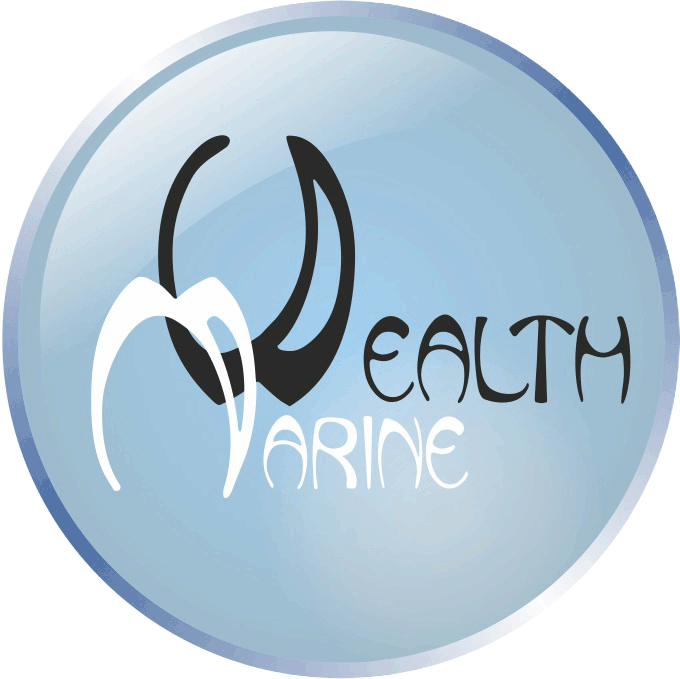
 |
|
||||||||
19. Methodological approaches of efficiency estimation of the investments in marine industrial activity
In the marine industrial activity the estimation of investments efficiency as the business planning element is made mostly with a view of attraction of investors and the venture capital for serial vessel manufacturing (or vessel batch) or for manufacturing of another real asset of the marine company, and also for purchase at the second–hand market.
The evaluation of investments efficiency is an integral task in the sphere of applied economics, since the value estimation and efficiency are pair dialectic categories: value is defined in relation to efficiency and vice versa, and thus any subject of applied economics is directed to the value or efficiency determination.
And more, in some subjects the value and the economic efficiency are interchangeable concepts. So, the value of investments (that is the characteristic index of a sum of money for which the investments are bought), for example, the loan value, can be defined by the interest rate which, on the other hand, is the characteristic of investments efficiency.
In this sense the concept of appraisal activity is a synonym of applied economics that is a scope of economic laws in the subjects of investment planning and expertise, unlike the theoretical research economy aimed at studying the economic laws.
The systematic approach is used as bases of methodology of efficiency estimation. The marine industrial object estimated in view of evaluation or efficiency is considered as a complex system, that is, a kind of a system which can not be evaluated, other than the structure consisting of subsystems.
And the marine industrial object estimated as a complex system consisting of subsystems, possesses the properties which are present in separate subsystems, and the new properties arising when combining subsystems in the structure of the marine industrial object.
For example, if to present a marine cargo vessel figuratively as a structure of two elements: the hull characterized by the property of tonnage (among other properties), and the ship main engine characterized by power, then the combination of these elements gives a new property – carrying capacity, which absent in the specified separate parts of the commercial vessel.
This a new property arising when combining of subsystems in a structure of marine industrial object that has the basic value in tasks of evaluation and economic efficiency estimation.
According to it the marine industrial object can be defined at two levels of generalization as a whole:
– Definition «maximum» as a set of all inherent properties, including presented in subsystems and arising when combining subsystems (continuing a figurative example concerning a marine cargo vessel: as a set of carrying capacity, tonnages and the of the ship main engine of the vessel);
– Definition «minimum» as new properties (for a commercial vessel – carrying capacity), arising when combining of subsystems and which are absent in the subsystems estimated separately.
It should be noted, that for commercial vessel the new property arising when combining the subsystems is usually connected with estimation of developed ocean resources: for the cargo vessel – the cargo traffics which when combining the subsystems of the cargo vessel are developed per formed property – the carrying capacity.
For the fishing vessel a new property, this arises when combining the subsystems, can be the productivity of ocean biological resources development. Examples can be continued concerning other kinds of marine industrial activity: development of deposits at offshore and also deep–water deposits, in the field of marine hydraulic engineering building, the mariculture, the water–power engineering etc.
Concerning property complex of the marine company, a new property arising when combining of real assets in a structured set, is a group unidentifiable intangible asset – goodwill estimated as advantages in access to resources and the purpose of innovative investment of financial assets in real assets which thereby at least corresponds to definition of a property complex.
On the basis of the systematic approach for the evaluation and efficiency estimation of the marine industrial object which is of the complex structure, the presence of a more general object is dialectically defined where the estimated object is a part of this structure.
Thus, the multilevel hierarchical system of objects of estimation is a consequence of marine industrial object complex structure at each level.
The investment planning of the marine industrial activity is evaluation of economic efficiency and a choice of optimum innovative strategy (in particular, optimum vessel characteristics in the order and quantities of vessels in a series) among comparable variants of investment. Thus, the concepts of investment variants comparability necessary for the economic evaluation are based on the systematic approach. It is impossible to compare, let us assume, a commercial vessel and a shipping company and to evaluate them by economic criterion (for example, by the profitability) for the purpose of a choice of the best variant of investment.
The marine industrial objects on case of estimation of variants efficiency of investment should be comparable, should be similar in everything, except the estimated differences. And the estimation and the choice among non–comparable variants of investment should be the methodological error.
From the point of the systematic approach view methodologically similar objects evaluated in the structure of a more general object that is for comparability of innovative strategy variants it is required to determine what object is more general among other marine industrial object for all compared variants estimated by the efficiency index.
The algorithm for comparison of variants is based just on identifying the most general marine industrial object. Characteristics of a more general object are initial data (limitations) for estimation of efficiency of investments.
For example, in order to choose the optimum vessel characteristics for commercial order among the vessel of the same cargo line the variants of marine commercial vessel with different characteristics should be compared by the economic criterion. Thus the comparison of variants on the basis of estimation of their efficiency indexes should be carried out in the structure of an identical more general object, in particular the marine cargo traffic with the account its intensity, extent, standards of transport service, characteristics of cargo base etc.
Test questions
1. Purposes of efficiency estimation of investments into assets and the property complex of the marine company.
2. Methodological proximity and interchangeability of the concepts of value and efficiency.
3. Systematic approach as basis of economic methodology.
4. Vessel, as a probabilistic system in a structure of subsystems.
5. Methodological definition of marine industrial object in the aggregate of its properties.
6. Properties of commercial vessel connected with developed marine wealth.
7. System definition of a more general object in relation to the evaluated one.
8. Methodological comparability of marine industrial objects.
9. Characteristics of a more general object as initial data for a comparative evaluation of options.
19.1. Economic indexes and the efficiency criteria of a commercial vessel or any other marine company asset
To estimate investment estimation for renovation or replenishment of commercial vessels fleet, and also to choose a new–building vessels or to estimate investments efficiency for the construction of other assets of the marine company the following economic criteria are usually applied:NPV = DCF – (MV+OC). |
(19.1) |
NPV = (IRR / i – 1) × (MV+OC). |
(19.2) |
|
(19.3) |
DCF=MV3+OC=NOI/R. |
(19.4) |
MV+OC=a×MV1+(1-a)×MV2+OC , |
(19.5) |
NPV=MV3-a×MV1-(1-a)×MV2 . |
(19.6) |
IRR + i × (NPV / (MV+OC) + 1). |
(19.7) |
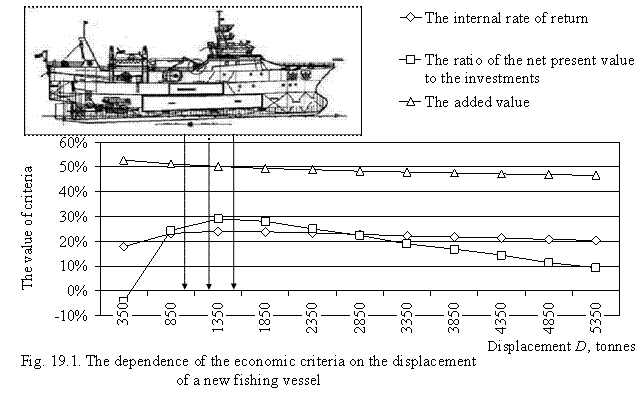
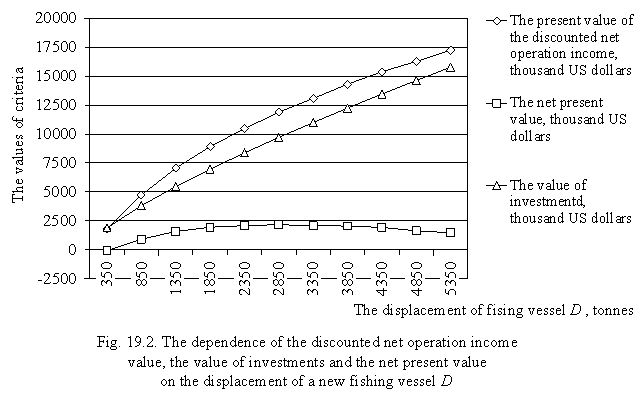
The dependences of the economic criteria of the internal rate of return and the net present value from years of the fishing vessel planned to be purchased at the second–hand market, and also the dependence of the generalized criterion (under the formula 19.7) are presented on charts (fig. 19.3).
As an additional index of investments efficiency, if the criteria of the internal rate of return IRR and net present value NPV do not give the chance to make exact choice among comparable variants of investment (vessel characteristics in the order or other asset as a part of the marine company complex, options of innovative strategy), that is, to specify the results among the limited quantity of the options chosen by the specified indexes of efficiency, it is possible to apply the additional criterion which should be formulated on the basis of alternative judgments about economic efficiency.
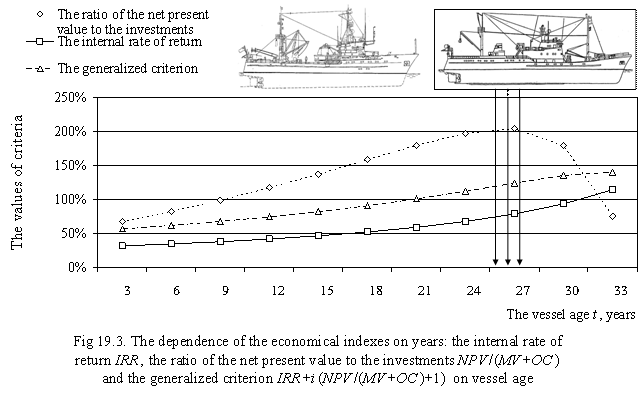
For example, in order to determine the vessel’s optimal characteristics it can be recommend applying the value added index as an additional (specifying) criterion which can be determined ising commercial vessel economic models as I – C + ÑCR + ÑFED + ÑEXP +ÑSOC + ÑMM + ÑDS ,or to evaluate this index relative value as a part of manufacturing or services value per unit of income:
(I – C + ÑCR + ÑFED + ÑEXP +ÑSOC + ÑMM + ÑDS) / I , or |
(19.8) |
where ![]() – the sum of the operation costs terms related to the added value according to manufacturing or services (except services of the contractor companies, material expenditures etc.) estimation.
– the sum of the operation costs terms related to the added value according to manufacturing or services (except services of the contractor companies, material expenditures etc.) estimation.
Test questions
1. The economic index of the net discounted income.
2. The economic criterion of the net present value.
3. The criteria of the internal rate of return and investments payback period.
4. The basic economic indexes which are not criteria.
5. The approaches used in investments evaluation for determining the economic criteria.
6. The criterion of the commercial vessel net present value from the point of the parties – the buyer and the seller.
7. The independence in the combination of indexes and the criteria of the net present value, internal rate of return and investments.
8. Estimation of the value of investments of the property complex as a starting limitation for assets accumulation and capitalization.
9. The dependence of economic efficiency criteria on investor’s financial constrain.
10. The reflexion of the present and prospective profitableness by the criteria of internal rate of return and net present value.
11. The recommended parity of the net present value criteria and the internal rate of return in the structure of the generalized criterion.
19.2. Determination of cargo vessels characteristics for the commercial order based on example of ferries for Pacific transportations
Further the vessels with horizontal loading (rolling cargo, ferries) are considered as an example of the comparative estimation of options, comparisons by economic criteria and the choice of cargo vessel in the commercial order with the account comparability.
Rolling cargo vessels with horizontal loading – ferries and RO–RO (roll on – roll off) can be used for transportation trackless or rail cargoes. In the second option usually the vessel is multipurpose, that is, she serves for transportation both rail cargoes and trackless ones.
Despite the big specific cubic capacity of the cargo and the tonnage, rolling cargo vessels in shipbuilding terminology are low–board in view of the main deck arrangement of transverse water–proof bulkheads since the cargo premises are continuous along the vessel.
Available in information databases projects of rolling cargo vessels offered for manufacturing and sale can be presented with the account the nomenclature of structural options:
1. The marine passenger–and–freight ferries for average and long distances transportation. The propellers are placed in the aft peack, the superstructure is along the vessel length, and the engine room is in the aft. There is a full or a rather considerable quantity of cabins on board the vessel.
2. The marine passenger–and–freight ferries for transportation at small distances. Passengers take places mostly in salons; there is a small amount of cabins. The propellers are in both peacks. The vessel is symmetric concerning the midel–frame.
3. Rolling cargo vessels with horizontal loading RO–RO differ from ferries where places for passengers are not provided (or only few places or cabins are provided). The superstructure is located at the fore or aft parts, the engine room – in the aft part.
The closest class of vessels to rolling cargo vessels with horizontal loading RO–RO by the project are the deck car ferries manufactured and operated for transportation of large lots of cars without passengers (or with the minimum facilities for passengers transportation), for example for transportation of new cars from enterprises for sale.
4. High–speed marine passenger–and–freight ferries one–hull and multihull may conceptually be projected as two–regime and depending on loading to be operated as in displaced mode with economic speed from 15 to 25 knots, and in high–speed mode (from 30 to 40 knots) – for transportation cargoes of the big cubic capacity and small specific weight, that is with less loading.
The further development of the concept of high–speed marine passenger–and–freight ferries vessels are the cushion–crafts or wing in surface effect ships (wing ships) which are an intermediate link between the ferry and a seaplane by the design. Structural similarity to the ferry is that the ramp is also used for loading–unloading, and a cargo premise is continuous along the vessel length.
As there are structural analogies of marine vessels and planes (and even there is a well known fact that the construction of planes started from the first «Boeing»– a seaplane), it is possible to consider, that among commercial vessels the closest structural analogues of planes are vessels with horizontal loading (marine passenger–and–freight ferries and RO–RO). And high–speed ferries can be equipped with a power–plant with gas turbines, entirely or partially made of aluminum alloys that prove analogy.
Concerning designing of vessels, comparisons of options and choice of characteristics it should be mentioned the contribution of professors: V.M. Pashin, B.A. Tsaryev, A.N. Vashedchenko, G.F. Demeshko, I.G. Zakharov made to the development of systematic approach methodology. Unlike the majority of their works the basic part of the given book is devoted to economic concepts which should be used in vessels and marine engineering designing, as well as in process of the formation of the structure of marine company’s property complex, that is, for dealing with of financial assets innovative advancement in the ocean industry.
The first step for a comparative estimation is the formation of the set of compared so that, keeping to similarity and system concepts of comparability the compared variants for determination of vessel characteristics for the order should have sufficient distinctions which must reflect the variety of the investor’s possibilities. At the same time, compared options should cover all the basic alternatives.
To estimate efficiency of investments by the economic criteria of internal rate of return and net present value the following variants of new marine vessels with horizontal loading are compared.
Variant 1. Concerning the possibility of commercial vessel purchase at the second–hand market the marine twin–screw passenger–and–freight ferry «Amelia» constructed in 1989 (the shipyard of Sunderland, converted in 1997 at the shipyard in Greece) is analyzed.
Variant 2. The commercial vessel with horizontal loading RO–RO with the container capacity 397 TEU constructed in 1985 with an ice class 1A (shipyard Rauma–Repola, Finland).
Variant 3. The marine passenger–and–freight ferry offered for construction at enterprise Flensburger Schiffbau–Gesellschaft mbH and Co. KG, Flensburg, Germany.
Variant 4. The commercial vessel with the horizontal loading RO–RO 5200 (5000), offered for construction at Flensburger Schiffbau–Gesellschaft mbH and Co. KG.
Variant 5. High–speed marine passenger–and–freight one–hull ferry offered for construction by the project of the company Tenix Defence Pty Ltd project, Marine Division, Australia.
The specified five possible alternatives cover a range of modern functionally comparable vessels which are estimated at the cargo traffic between continental the coast of East Asia and Japan.
To make comparative estimation of options, the comparisons by economic criteria and to make a choice of rolling cargo vessel for the commercial order it is necessary to execute a complex study and to solve a number of tasks, among which are:
– Analysis of development prospects of marine cargo traffic between Japan harbors and the continental part of East Asia;
– Analysis of investment risks into passenger–and–freight shipping;
– Market research, cargo and passenger traffic amount and prospects of passenger–and–freight transportations development in the seas of western and northern districts of Pacific ocean;
– Marketing researches and statistical generalizations concerning the market of vessels with horizontal loading (vessels of new construction and the second–hand market vessels which have already been in operation);
– Estimation of a prospective shipyards–contractors for marine vessels manufacture with horizontal loading (with the account the national accessory);
– Formation of the set of the options for fleet replenishment with marine vessels with horizontal loading estimated by economic criteria with the account the following characteristics – the structural class of the commercial vessel, the vessel size, the vessel years (for assumptions of investment in manufacturing of the new commercial vessel or the vessel that were in operation);
– Working out of the economic models of marine vessels with horizontal loading, including dependences between the data (the characteristic vessels–applicants and data of cargo traffics), on the one hand, and results (economic criteria of investments efficiency), on the other hand;
– Estimation of investments efficiency into the purchase / manufacturing of vessels with horizontal loading on the basis of application of the developed models and working out of recommendations concerning future vessel among the studied set of alternative options.
The evaluation and efficiency estimation in northwest area and the coastal seas of Pacific ocean is made for prospective operation of vessels of studied set on a similar methodological basis which covers approaches and mathematical models of economical indexes determination for each of vessels as a part of a property complex of the shipping company with similar external data: the characteristics of trip line, the date of the estimation, tariff rates for transportation of passengers, the cars and rolling cargoes, the quotations for fuel, the commercial risks calculated according to the discounting rate, the other macro economical indexes, etc.
As independent criteria of economic efficiency the following indexes are used: internal rate of return IRR and net present value NPV. And in order to compare two values the index of the net present value NPV is considered by the relative value – in relation to investments NPV / (MV + OC).
The diagrammes for the compared variants of rolling cargo vessels show the estimation of investments demand (fig. 19.4), the general structure of operation costs (fig. 19.5), the estimation of economic criterion of the net present value (referred to investments, fig. 19.6), the estimation of internal rate of return (fig. 19.7).
The basic disadvantage of the high–speed sea passenger–and–freight ferry under project Tenix Defence Pty Ltd. in the present macroeconomic conditions is the excessive fuel consumption that limits possibilities of application of similar (high–speed) vessels for transportation of cargoes at the considered line.
|
|
|
|
The generalized criterion on the basis of indexes of internal rate of return and net present value (fig. 19.8) allows to judge advantages of the following options of the rolling cargo vessels: the ferry "Amelia" offered at the second–hand market and variants of the marine passenger–and–freight ferry and commercial vessel with horizontal loading RO–RO 5200 (5000) offered for manufacturing at shipyard Flensburger Schiffbau–Gesellschaft mbH and Co. KG.
By the relative value of criteria the best indexes of efficiency (the internal rate of return, the net present value referred to investments) correspond to variant of marine twin–screw passenger–and–freight ferry "Amelia" of 1989 year manufacture of the shipyard of Sunderland offered at the second–hand market.
It should be noted, that the vessel «Amelia» is estimated at the second–hand market and has considerably smaller value, than a comparable new vessel, besides, the functional vessel characteristics vary over the time not so substantially, as the value does.
The vessel depreciation causes over the time the difference of economic criteria in comparison with the new vessels. On the other hand, investments into purchase of vessels at the second–hand market are more risky. The all–round analysis and a choice with the account the estimation of risks of the second–hand market is required (paragraph 18.2).
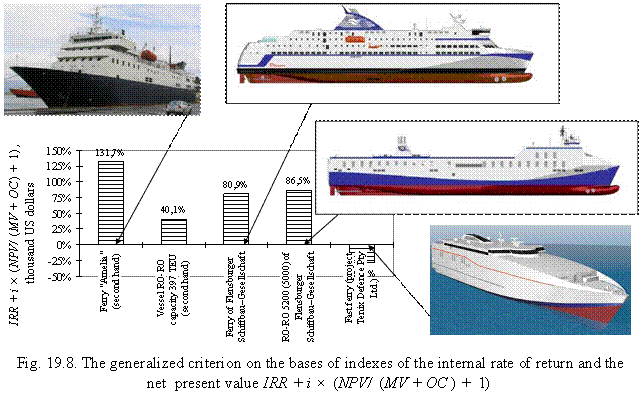
Test questions
1. Classes of the rolling cargo vessels and their advantages.
2. Rolling cargo vessels structural design features.
3. High–speed cargo vessels economic disadvantages.
4. Concepts of the systematic approach when determining commercial vessel options compared by economic criteria.
5. Economic criteria used for a comparative evaluation of commercial vessel options for the order.
6. Main tasks fulfilled to evaluate comparatively the variants of the commercial vessel choice for the commercial order.
7. Similar methodological basis used for evaluation of variants as a system requirement for comparison and choice.
8. Form of the generalized economic criterion on the basis of internal rate of return and net present value indexes.
9. Economic advantages and disadvantages of commercial vessel purchase at the second hand market.
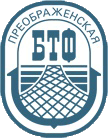 |
 |
|||||